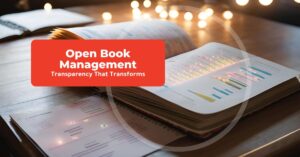Goals, Strategies & Annual Planning: The Future of Business is Personal
Sep 24, 2021
Shifting ideas and ideals are impacting your ability to plan for next year and beyond. From pandemic realities to acknowledging the “Great Resignation”, new energy on diversity in the workplace, and employees embracing a more personal, relationship-driven work experience, the modern business leader and business must adapt not only to keep up, but to lead.
Goals and Strategies are Changing
We’ve explored before how the pandemic has been, in many ways, simply an accelerator where business is concerned. Innovative companies found new ways to innovate. Companies struggling with strong culture had those weaknesses laid bare with remote working. Of course new issues were created, but many issues that already existed just came quickly into focus.
This is perhaps most true with personal connection. How does our team feel maybe wasn’t always among the top questions when planning for the next year. “Goals and strategies” generally indicates revenues, profits, forecasts and models. Certainly they still do, but as the workplace has changed, so has the workforce. With labor shortages, the “Great Resignation”, diversity and equity concerns at the forefront, younger generations becoming managers – high performance companies will have to adjust their planning to make sure personnel means personal.
Wisdom at Work
Let’s unpack the generational workforce just a bit. Remember a few years ago when every article you read breathlessly wondered what are Millennials thinking?! as companies tried to better understand everything from their labor potential to their buying power. In a blink-and-you-missed it turn of events, those Millennials are now managers and executives, driving company cultures and long-range strategies. Now organizations are trying to build stronger relationships with Gen-Z – the emerging workforce and a dominant marketplace.
Each of these generations is bringing something to work that Boomers and Generation X simply didn’t possess; an inherent, lifelong relationship with modern technology. With that possessions comes a familiarity with concepts like social sharing, digital activism, even communication styles like shorthand texting, emojis and memes. It’s a basic example to illustrate a broad concept – what’s natural and easy for one group seems awkward and strange to another. Bridging that potential divide requires personal attention in the workplace and marrying this enthusiasm with the wisdom Boomers and Gen-Xers possess.
Meanwhile, people don’t retire anymore at 65. Serial entrepreneurs will keep starting and building businesses long into life. The more experienced among your workforce have much to teach and guidance to deliver, but a future-thinking, forward-thinking strategic mindset is in order.
Planning Ahead
Instead of sitting down in the fall to help organizations plan out next year, we at ProCFO Partners are thinking farther out. What’s the vision for two, three, even four years out? How is the leadership of seasoned employees and executives combining with new energy of emerging workforces? How are those practices being systematized and processed? Managing KPI’s for the future is and will always be a cornerstone of annual planning, and your CFO should be a crucial part of those discussion. But as you’re thinking internally, think personally and about the people who aren’t in the room building goals and strategies.
This makes practical the earlier concept of engaging today’s workforce. In an organization where most executives – and so, the planners and strategists – are conditioned to think about bonuses and rewards that are built-in to performance achievement, the emerging workforce is often less motivated by financial incentives. They’d rather have more flexible work hours or environments, healthier workplace relationships (including with managers), fulfilling work experiences, even easier and more affordable transportation and housing. Where a previous workforce might stay in a less enjoyable job because “the pay is pretty good,” newer employees won’t. Your culture, as it’s always been, is either a competitive and hiring advantage – or it isn’t. Now more than ever, there’s no hiding behind KPI’s or sales achievements if yours needs work. These conversations must be part of your goals, strategies, and annual planning.
Connected and Collaborative
In some ways we’re all living through, in real time, the reimagining of work. How many of us are realizing that even for its frustrations, online meetings are pretty efficient? That virtual conferences might be a sustainable and viable option to the 3-day annual event two flights away? That some of us are more productive at 2am than we are at 2pm – and our workplace can benefit from that with more flexibility? While we’ll certainly resume the familiar at some point, it’s hard to imagine we’ll ever go back fully to what we were used to. How will this change management? Workplace dynamics? Hiring? Even capital investments? Time will tell, but one characteristic of the high performance, innovative organizations that will continue to thrive no matter what is an inherent, structural concern for its people first. Companies that put people at the heart of their goals, strategies, and annual planning will find themselves more future-proof, more desirable, and more capable of weathering outside stressors.
Sign Up for Our Newsletter
Get expert perspectives and actionable strategies to empower your business growth.
"(Required)" indicates required fields


